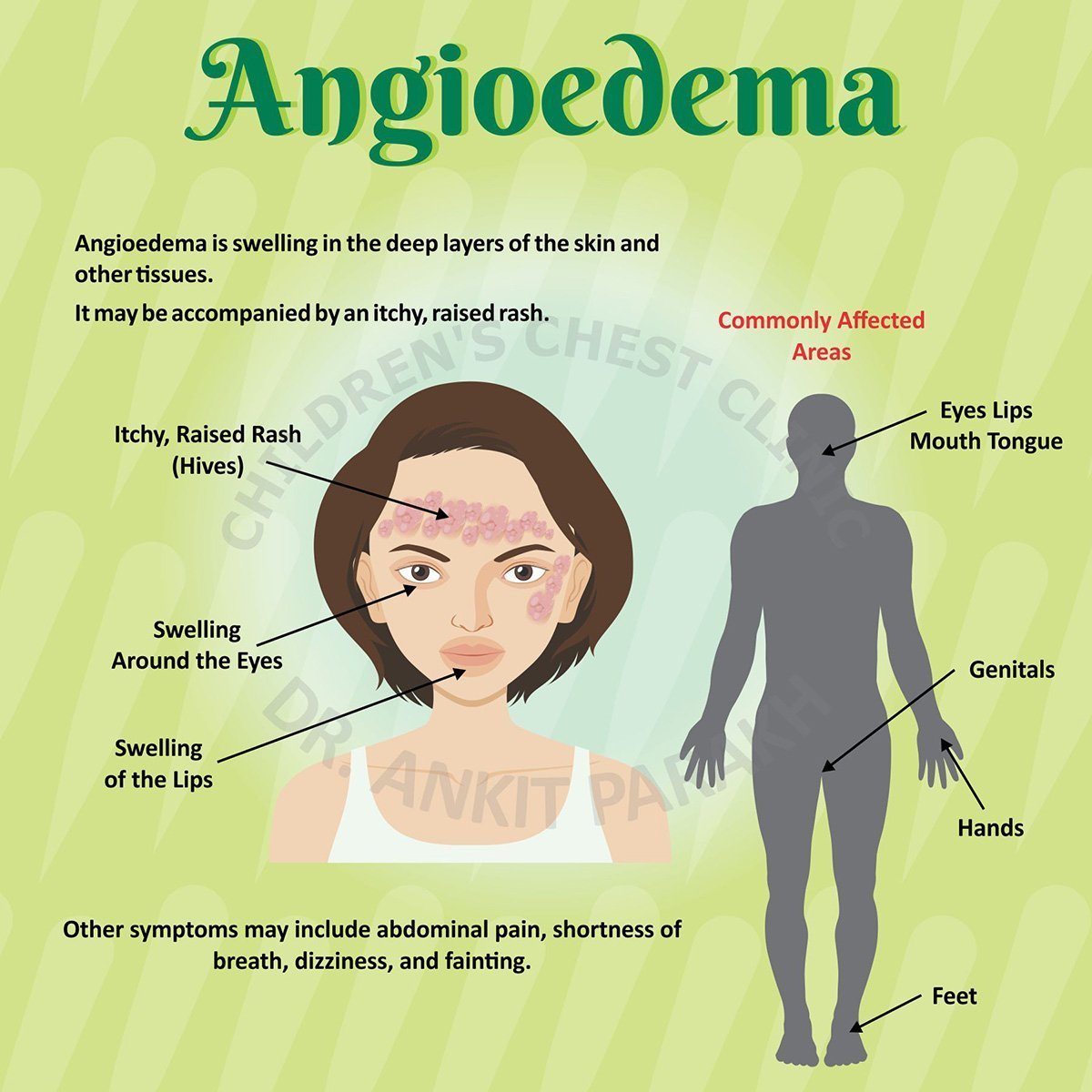
Angioedema in Children
What is Angioedema?
Angioedema is caused by fluid leakage from blood vessels into deeper layers of the skin and mucosal tissues. It can result from allergic reactions, infections, medications, or hereditary conditions. In children, it may occur as a standalone condition or alongside urticaria.
Types of Angioedema in Children
- Allergic Angioedema: Triggered by allergens such as food, insect stings, or medications, this type is often accompanied by urticaria.
- Non-Allergic Angioedema: Caused by medications like ACE inhibitors or physical triggers such as pressure or cold.
- Hereditary Angioedema (HAE): A rare genetic disorder caused by a deficiency or dysfunction of the C1-inhibitor protein. HAE episodes are typically not associated with urticaria and can be life-threatening if they involve the airways. In kids with chronic or recurrent angioedema with no obvious cause or if family members have angioedema a possibility of hereditary angioedema should be kept.
Symptoms of Angioedema
- Sudden swelling, usually around the eyes, lips, tongue, or hands and feet.
- Swelling in the throat or airways, causing difficulty breathing or swallowing.
- Abdominal pain, nausea, or vomiting (in hereditary angioedema).
- Urticaria (in cases linked to allergic triggers).
What are the causes of Angioedema in children?
Angioedema can be caused by:
- Viral infections: these are the most common cause of acute urticaria and angioedema in children. Most common viral infections are related to respiratory (like viral upper respiratory infections) and gastrointestinal infections (like gastroenteritis).
- Foods: can trigger allergic reactions leading to angioedema and hives. The common foods are peanuts, tree nuts, fish, eggs, soy and milk
- Medications: Many medications may cause hives or angioedema. Common culprits include antibiotics (most commonly penicillin group), analgesic medicines (aspirin, ibuprofen, naproxen sodium) and anaesthesia medicines.
- Environmental factors: Examples include long sunlight exposure, hot showers or baths, pressure on the skin such as from tight clothing, emotional stress, insect bites and exercise can lead to urticaria and angioedema.
- Hereditary Angioedema
Diagnosing Angioedema in Children
A thorough medical history and physical examination are essential. The cause of angioedema is often clear from the description and investigations are usually not required. When angioedema is chronic additional tests may include:
- Allergy Tests: To identify triggers in allergic angioedema.
- Blood Tests: If hereditary angioedema is suspected C1 inhibitor levels, C1q esterase and C4 levels are required.
- Imaging: May be required in severe abdominal cases.
Managing Angioedema in Children
For Allergic Angioedema:
- Immediate administration of antihistamines to reduce swelling.
- Epinephrine injection in cases of severe reactions or anaphylaxi
For Hereditary Angioedema:
- Prophylactic treatments with C1-inhibitor replacement therapy or newer medications targeting specific pathways.
- Acute attacks require on-demand treatments like C1-inhibitor concentrate or bradykinin inhibitors. Fresh frozen plasma might be administered if these newer drugs are not available.
Trigger Avoidance:
- Identify and avoid known triggers such as specific foods, medications, or environmental factors.
Emergency Preparedness:
- Parents and caregivers should have an action plan and emergency medications ready for sudden attacks.
Angioedema in children can range from mild to life-threatening, depending on the type and severity. Early diagnosis and appropriate management are crucial to preventing complications. For expert care and guidance, consult a pediatric allergist, to ensure the best outcomes for your child.
Conclusion
Frequently Asked Questions (FAQs)
1. Is angioedema life-threatening?
While most cases are mild and resolve on their own, severe angioedema involving the throat or airways can be life-threatening and requires immediate medical attention.
2. How is hereditary angioedema different from allergic angioedema?
Hereditary angioedema is genetic, often lacks urticaria, and does not respond to antihistamines, unlike allergic angioedema.
3. Can angioedema be cured?
There is no cure for hereditary angioedema, but it can be managed effectively with prophylactic and on-demand treatments.
4. What should I do during an angioedema attack?
Administer antihistamines or epinephrine (if prescribed) and seek immediate medical care if symptoms worsen or involve breathing difficulties.
5. How can I prevent angioedema in my child?
Identify and avoid triggers, keep emergency medications on hand, and consult a specialist for a personalized management plan.



